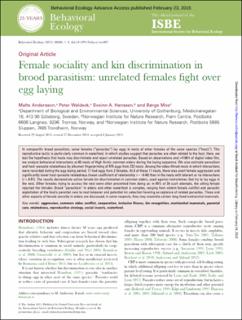Female sociality and kin discrimination in brood parasitism: Unrelated females fight over egg laying
| dc.contributor.author | Andersson, Malte | |
| dc.contributor.author | Waldeck, Peter | |
| dc.contributor.author | Hanssen, Sveinn Are | |
| dc.contributor.author | Moe, Børge | |
| dc.date.accessioned | 2023-07-06T11:43:51Z | |
| dc.date.available | 2023-07-06T11:43:51Z | |
| dc.date.created | 2015-03-05T10:40:58Z | |
| dc.date.issued | 2015 | |
| dc.identifier.citation | Behavioral Ecology. 2015, 26 (3), 755-762. | en_US |
| dc.identifier.issn | 1045-2249 | |
| dc.identifier.uri | https://hdl.handle.net/11250/3076587 | |
| dc.description.abstract | In conspecific brood parasitism, some females (“parasites”) lay eggs in nests of other females of the same species (“hosts”). This reproductive tactic is particularly common in waterfowl, in which studies suggest that parasites are often related to the host. Here, we test the hypothesis that hosts may discriminate and reject unrelated parasites. Based on observations and >4100 h of digital video film, we analyze behavioral interactions at 65 nests of High Arctic common eiders during the laying sequence. We also estimate parasitism and host–parasite relatedness by albumen fingerprinting of 975 eggs from 232 nests. Among the video-filmed nests in which interactions were recorded during the egg-laying period, 11 had eggs from 2 females. At 8 of these 11 nests, there was overt female aggression and significantly lower host–parasite relatedness (mean coefficient of relationship r = −0.40) than in the nests with tolerant or no interactions (r = 0.91). The results demonstrate active female kin discrimination in common eiders, used against nonrelatives that try to lay eggs in the nest. Other females trying to access the nest were often prevented from doing so: in 65% of 34 such attempts, the sitting female rejected the intruder. Brood “parasitism” in eiders and other waterfowl is complex, ranging from violent female conflict and parasitic exploitation of the host’s parental care to nest takeover and potential kin selection favoring acceptance of related parasites. These and other aspects of female sociality in eiders are discussed; in some respects, they may resemble certain long-lived matriarchal mammals. aggression, common eider, conflict, cooperation, inclusive fitness, kin recognition, matriarchal mammals, parental care, relatedness, reproductive strategy, social insects, waterfowl. | en_US |
| dc.language.iso | eng | en_US |
| dc.rights | Navngivelse-Ikkekommersiell 4.0 Internasjonal | * |
| dc.rights.uri | http://creativecommons.org/licenses/by-nc/4.0/deed.no | * |
| dc.subject | aggression | en_US |
| dc.subject | common eider | en_US |
| dc.subject | conflict | en_US |
| dc.subject | cooperation | en_US |
| dc.subject | inclusive fitness | en_US |
| dc.subject | kin recognition | en_US |
| dc.subject | matriarchal mammals | en_US |
| dc.subject | parental care | en_US |
| dc.subject | relatedness | en_US |
| dc.subject | reproductive strategy | en_US |
| dc.subject | social insects | en_US |
| dc.subject | waterfowl | en_US |
| dc.title | Female sociality and kin discrimination in brood parasitism: Unrelated females fight over egg laying | en_US |
| dc.type | Peer reviewed | en_US |
| dc.type | Journal article | en_US |
| dc.description.version | publishedVersion | en_US |
| dc.rights.holder | © 2015 The Authors | en_US |
| dc.subject.nsi | VDP::Matematikk og Naturvitenskap: 400::Zoologiske og botaniske fag: 480 | en_US |
| dc.source.pagenumber | 755-762 | en_US |
| dc.source.volume | 26 | en_US |
| dc.source.journal | Behavioral Ecology | en_US |
| dc.source.issue | 3 | en_US |
| dc.identifier.doi | 10.1093/beheco/arv007 | |
| dc.identifier.cristin | 1229596 | |
| dc.relation.project | Norges forskningsråd: 176046 | en_US |
| cristin.unitcode | 7511,4,0,0 | |
| cristin.unitcode | 7511,2,0,0 | |
| cristin.unitname | Tromsø | |
| cristin.unitname | Avdeling for terrestrisk økologi | |
| cristin.ispublished | true | |
| cristin.fulltext | original | |
| cristin.qualitycode | 2 |
Tilhørende fil(er)
Denne innførselen finnes i følgende samling(er)
-
Publikasjoner fra CRIStin - NINA [2397]
-
Scientific publications [1423]
Vitenskapelige artikler, kapitler og monografier i Open Access.

